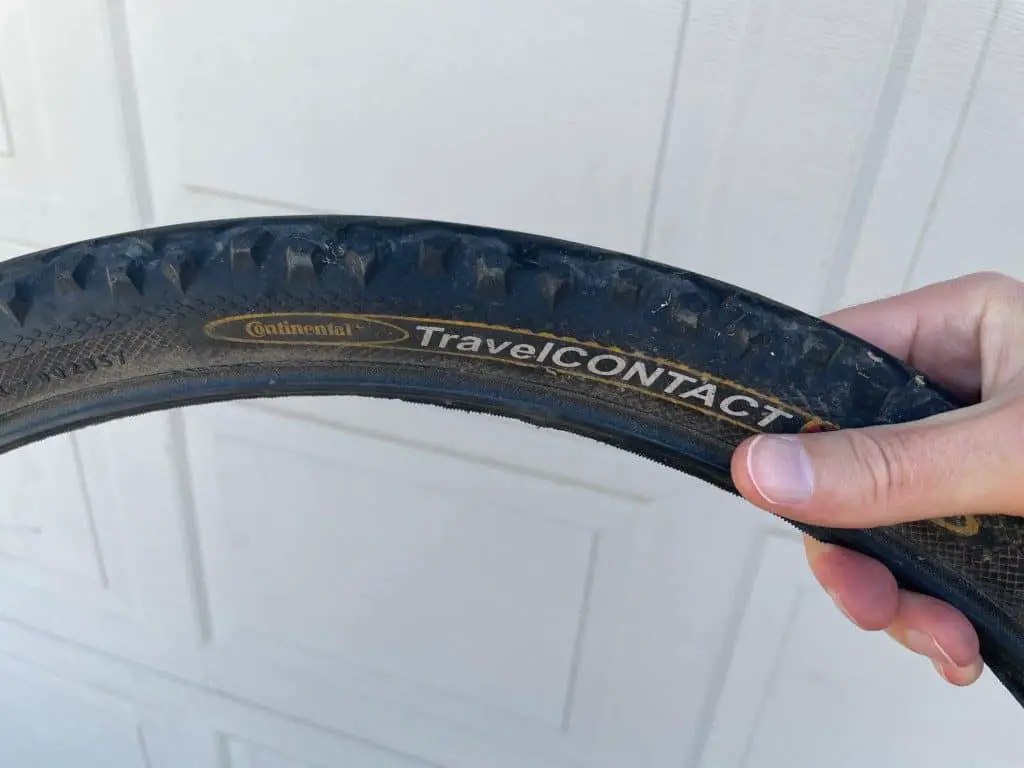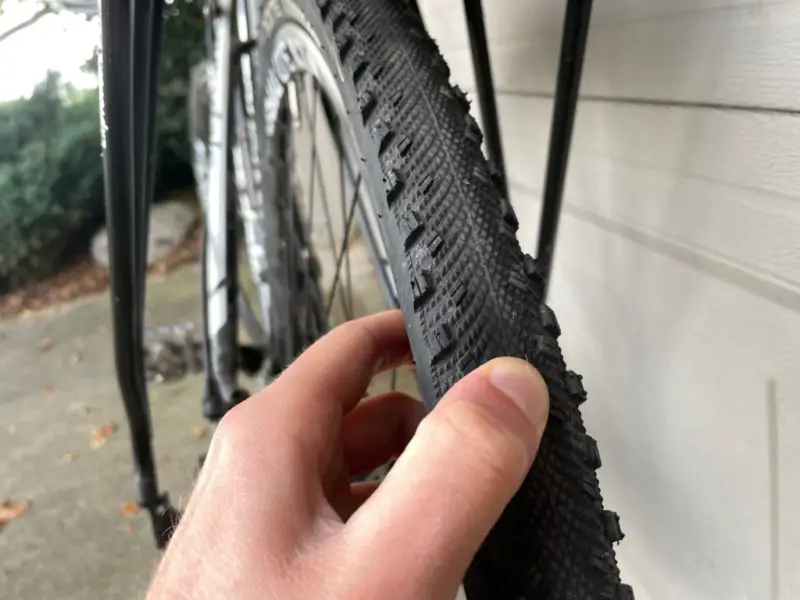Have you ever noticed that a tire is most difficult to put on when it’s brand new? With every application, the tire gets easier to install. Why is this? Is the tire stretching? Or is your rim shrinking?
Do Bike Tires Stretch Over Time?
Once a tire is installed and inflated it begins to expand from its original size, but not drastically. You will notice your tires stretch slightly as they wear. A tire experiences the most stretching within the first 24 hours of being installed and inflated. After that, your tires will stay roughly the same size.

How Much Bike Tires Stretch
It is normal for a bike tire to grow 2-3mm after the first day of being installed. But how much your tires will stretch depends on the specific model and how thick the casing is. These can have a considerable affect on how much your tires will expand. For instance, a thinner road or cross-country mountain bike tire will stretch more than an enduro or downhill mountain bike tire.
Your tire’s rubber compound also make a difference. Harder compounds (more common in budget-friendly tires) tend to stretch less, while softer compounds (used for racing or when maximum grip is needed) will stretch a bit more.
Even the fabric cords threaded within the tire casing can affect how much the tire stretches. Tires with extra sidewall protection have a thicker weave of cords, which may limit your tire’s ability to expand.
Whether your tires are tubed or tubeless also has an effect. You may experience a bit more stretch if you run your tires tubeless since the air is exerting pressure directly on the tire rather than a tube. You should be able to see that the tire has a noticeably fuller profile when it’s tubeless.
How Long It Takes for Bike Tires to Stretch

Generally, it does not take long for a bike tire to stretch when it is new. Within 24 hours of installation, your tire will have expanded slightly. But this will differ depending on the tire. Tires with light, thin casings will not take as long to stretch compared to more durable downhill tires.
After that initial 24 hour period, it will take much longer for a tire to stretch noticeably again. But the longer a tire is ridden, the more it will expand. This is why old tires are so much looser than newer tires.
2 Causes of Expanding Bike Tires
1. Overinflating
Overinflating your tires once in a while won’t have a drastic impact, but do it regularly and they will lose some of their natural elasticity, causing them to stretch out.
Not only will this make your tires fit looser on your rims, but it could cause them to bulge out in certain places. This uneven shape would negatively affect your handling, cornering and braking, and shorten the lifespan of your tires.
Never exceed the maximum tire pressure listed on your tire’s sidewall.
2. Heat
Heat causes air to expand. When it comes to your tires, leaving them out in the sun or in extreme temperatures for an extended period of time will cause the air inside to take up more space. If the air can’t escape by unseating your tire or leaking through the valve, your tire will expand.
It’s possible that prolonged time under greater air pressure could ruin your tire’s shape or even cause it to rupture.
How Tight Should Bike Tires Be?
Let’s face it: getting a bike tire installed is not the easiest thing in the world. In fact, trying to stretch a bike tire over the rim while getting a tube (or tubeless sealant) to stay in place can be downright frustrating. But if you’re struggling, you’re not alone.
Bike tires should feel very tight over the rim. They have to be: if they were loose, as you inflate your tires the increasing air pressure in the tube would push them right off the rim if they didn’t fit snugly. This is even more of a concern with tubeless tires, where air would also be able to escape in between the tire bead and the rim.

To get your tire installed properly, you usually need to fill it to a higher pressure than you would ever ride with. This helps push the tire sidewalls up into the proper position on the rim (known as “seating” your tire) and lock them in place. You know you’re there when you hear a pop: don’t worry, it’s not the tire rupturing…though it did surprise me the first time I did it!
As I mentioned before though, you never want to inflate your tire past the maximum pressure listed on the sidewall. Once it’s seated, you can reduce the pressure to the proper level for you.
Don’t know what this level is? Check out our previous article all about bike tire pressure, where you’ll also find this handy tire pressure calculator to get you started.
But it’s not just about air pressure. Whether you run tubeless tires or not, the increased force of your body weight squishing the tires, along with accelerating, braking and cornering all put a lot of force on your tires. If they were too loose, they could slip right off your rim in a tight corner when they’re being compressed laterally.
What Causes a Bike Tire to Bulge?
A bulge in your tire means it’s suffered from some structural damage. Here are a few things that may cause your tires to bulge.
1. Poor Installation
A common cause of a bulging bike tire is poor installation.
If your tire is not evenly seated on the rim before it’s inflated, a bulge could form. Air will exert more pressure in certain areas of an unevenly seated tire, causing the tire to stretch more in some places than others.
If you use tubes, the inner tube will be able to push through the gaps between the tire sidewall and rim. Once you start riding this can cause the tube to rupture and can even shred the tire in the process.
It’s important to make sure the tire bead is seated properly all the way around your tire on both sides.
2. Wrong Size Inner Tubes
Just like tires, inner tubes have specific diameters and widths, and must be paired with compatible tires. Using a tube that is larger or wider than your tire will cause the tube to bunch up and exert uneven pressure on your tire. This will lead to the tire bulging out and wearing unevenly.
You can determine what size inner tube you need by identifying the diameter of your wheel and the width of your tire. Tubes often work with a small range of tire widths, so make sure you choose one with a range appropriate for your tire width.
3. Damaged Tire
Bulging can often be a result of damaged or worn out tires. Damage to the casing makes your tires especially vulnerable to bulging. Skidding, riding on rough surfaces and hitting hard or sharp objects can cause damage to the tire’s casing and lead to bulges.
4. Bad Tire Design
Cheaply made tires can get damaged very easily. It is not uncommon for bikes with poorly made tires to develop bulges and other defects much faster than tires that are well made.
However, even reputable brands can produce a defective tire once in a while. Check your tire’s shape and profile after installation to make sure it looks in good condition and rotates without any wobble.
